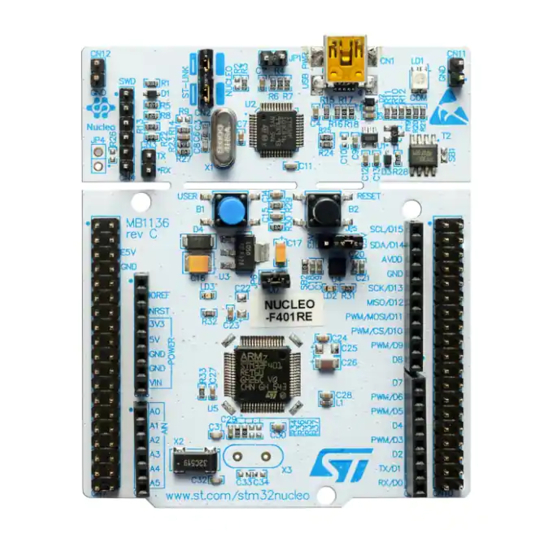
User Manuals: ST STM32F410 Microcontroller
Manuals and User Guides for ST STM32F410 Microcontroller. We have 1 ST STM32F410 Microcontroller manual available for free PDF download: Reference Manual
ST STM32F410 Reference Manual (771 pages)
Advanced Arm-based 32-bit MCUs
Brand: ST
|
Category: Microcontrollers
|
Size: 9 MB
Table of Contents
-
-
-
Bit Banding42
-
-
-
Introduction45
-
Option Bytes53
-
-
-
-
-
Sleep Mode77
-
Stop Mode79
-
Standby Mode82
-
-
Reset91
-
Clocks93
-
RCC Registers102
-
RCC Register Map133
-
-
-
-
SYSCFG Registers155
-
-
(Syscfg_Exticr1)157
-
(Syscfg_Exticr2)157
-
-
-
(Syscfg_Exticr3)158
-
(Syscfg_Exticr4)158
-
-
-
DMA Introduction162
-
-
DMA Overview164
-
DMA Transactions165
-
Arbiter167
-
DMA Streams167
-
Circular Mode172
-
Fifo175
-
Flow Controller179
-
Error Management182
-
DMA Interrupts183
-
DMA Registers184
-
DMA Register Map194
-
-
-
EXTI Registers206
-
-
CRC Introduction211
-
CRC Registers212
-
-
-
ADC Introduction215
-
-
ADC Clock217
-
Analog Watchdog219
-
Timing Diagram219
-
Scan Mode220
-
Data Alignment222
-
Data Management225
-
ADC Interrupts228
-
ADC Registers229
-
-
-
Introduction243
-
Noise Generation248
-
DMA Request250
-
DAC Registers251
-
-
(Dac_Dhr12L1)254
-
-
DAC Register Map256
-
-
-
Introduction257
-
RNG Interrupts263
-
-
Introduction264
-
-
RNG Registers265
-
-
-
-
Time-Base Unit271
-
Counter Modes273
-
Clock Selection284
-
PWM Input Mode291
-
PWM Mode293
-
One-Pulse Mode303
-
Debug Mode312
-
-
TIM1 Registers313
-
-
-
-
Time-Base Unit341
-
Counter Modes343
-
Clock Selection351
-
PWM Input Mode356
-
PWM Mode359
-
One-Pulse Mode362
-
Debug Mode368
-
-
TIM5 Registers369
-
-
-
Time-Base Unit393
-
Counter Modes395
-
Clock Selection398
-
PWM Mode405
-
One-Pulse Mode406
-
Debug Mode411
-
-
TIM9 Registers411
-
TIM11 Registers426
-
-
(Timx_Ccmr1)429
-
-
-
Introduction437
-
-
Time-Base Unit438
-
Counting Mode440
-
Clock Source443
-
Debug Mode444
-
-
TIM6 Registers445
-
-
-
Introduction450
-
-
Glitch Filter452
-
Prescaler453
-
Operating Mode454
-
Timeout Function456
-
Register Update457
-
Counter Mode458
-
Timer Enable458
-
Encoder Mode459
-
Debug Mode460
-
LPTIM Interrupts461
-
LPTIM Registers461
-
-
-
Debug Mode476
-
WWDG Registers477
-
-
IWDG Registers482
-
-
Introduction486
-
-
Tamper Detection498
-
Alarm Output500
-
RTC Interrupts501
-
RTC Registers502
-
-
(Rtc_Tafcr)517
-
-
RTC Register Map522
-
-
-
Introduction524
-
-
Mode Selection528
-
Software Reset533
-
Data Transfer534
-
Nostretch= 0540
-
Nostretch= 1541
-
Smbus Slave Mode563
-
Error Conditions570
-
DMA Requests572
-
Debug Mode573
-
FMPI2C Registers575
-
-
-
-
Mode Selection594
-
I2C Slave Mode595
-
I2C Master Mode598
-
Error Conditions604
-
Smbus606
-
DMA Requests609
-
-
I 2 C Interrupts611
-
I 2 C Debug Mode613
-
I 2 C Registers613
-
I2C Register Map626
-
-
-
Transmitter633
-
Receiver636
-
Parity Control654
-
Smartcard660
-
USART Interrupts668
-
USART Registers669
-
-
Introduction680
-
I2S Features682
-
-
SPI Status Flags698
-
SPI Error Flags699
-
-
TI Mode700
-
CRC Calculation701
-
-
SPI Interrupts703
-
-
Figure 252. I704
-
I2S Full-Duplex705
-
Figure 258. I708
-
Clock Generator713
-
Figure 272. I713
-
I 2 S Slave Mode717
-
I 2 S Interrupts720
-
DMA Features720
-
Table 127. I720
-
-
-
Mode726
-
-
SPI Register Map731
-
-
-
Overview732
-
JTAG Debug Port740
-
SW Debug Port742
-
SW-DP Registers744
-
SW-AP Registers745
-
Core Debug746
-
-
Introduction756
-
TPUI Formatter758
-
Synchronous Mode759
-
TPIU Registers760
-
-
DBG Register Map762
-
-
Revision History
765
Advertisement
Advertisement
